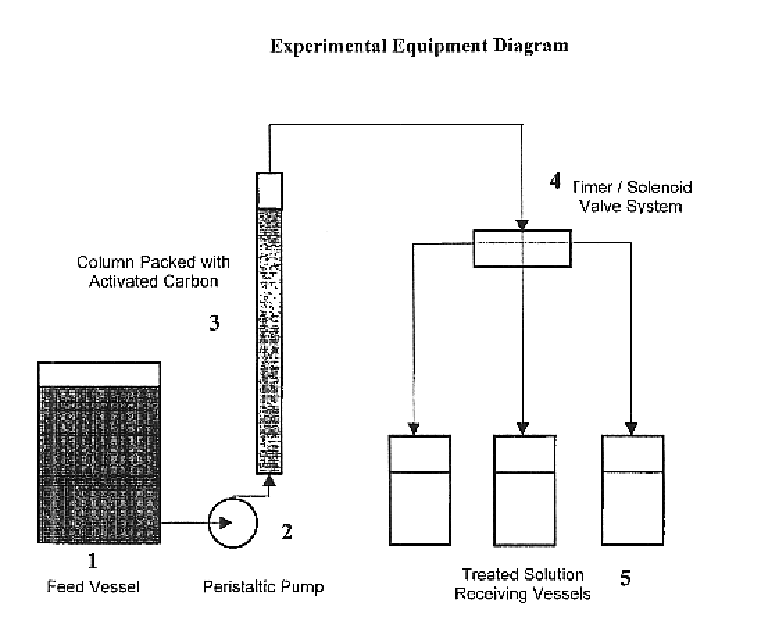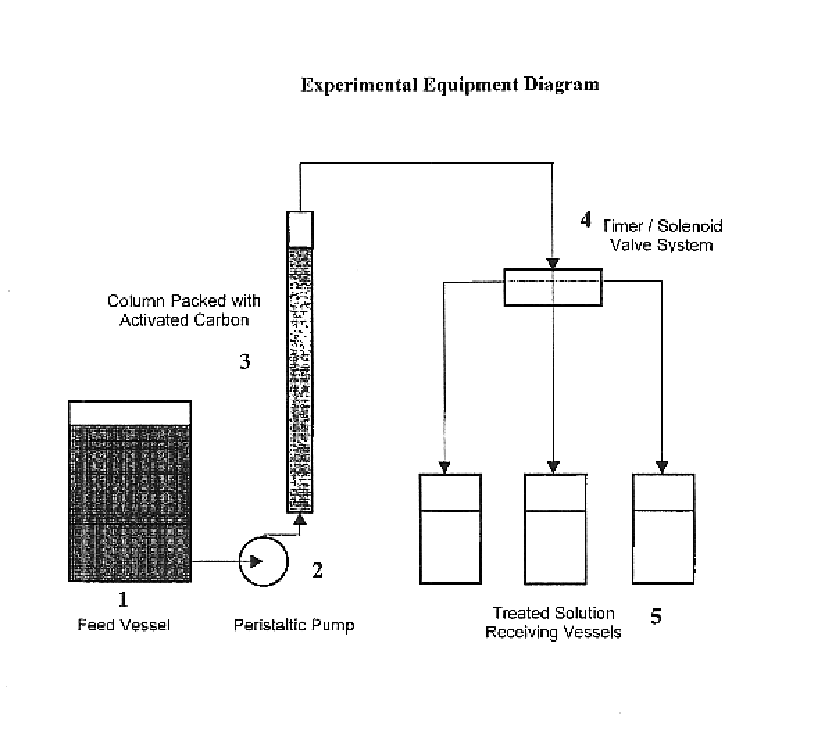Process for the recovery of sodium nitrite
a sodium nitrite and process technology, applied in the field of sodium nitrite recovery, can solve the problems of not being able to achieve comparable complete and practical impurity removal, not being able to demonstrate the use of any identifiable activated carbon to achieve complete removal of organic materials such that sodium nitrite could be generated as a salable product, and prior attempts to purify this type of sodium nitrite byproduct by removing or destroying
- Summary
- Abstract
- Description
- Claims
- Application Information
AI Technical Summary
Benefits of technology
Problems solved by technology
Method used
Image
Examples
example 1
[0022]Lignite-based granular Activated Carbon was used for the removal of organic contamination from a sample of 40% NaNO2 containing residual organics of about 6630 ppm TOC. The numbers in the description refer to the accompanying figure. A glass column (3) of 19.5 inches high and 1 inch in diameter was prepared for use in treating the solution. A peristaltic tubing pump (2) was attached at the column's base with size 13 tubing while the top was fitted with a stopper and tubing for the collection of the treated solution in a series of collection vessels (5). Lignite derived granular activated carbon (Darco 12×40 activated carbon obtained from Norit) was added dry, 50 grams, to the column to a height of 10 inches, corresponding to a bed volume of 128.7 cm3. The solution was pumped from a feed vessel (1) to the column in an upward-flow configuration at a 0.3 ml / minute (0.14 BV / hr) rate starting at 1430 hours on Day 1. By 1700 hours, the red-orange solution was just beginning to wet t...
example 2
[0028]Granular Activated Carbon was used for the removal of organic contamination from the same starting sodium nitrite solution as that of Example 1 and using equipment similar to that described in Example 1. Again, 50 grams of Norit 12×40 Darco granular activated carbon was used. In this test, the carbon was wetted with deionized water, then allowed to drain overnight prior to feeding the solution to be treated. The solution was pumped to the column in an upward-flow configuration, this time at a rate of 1.2 ml / minute (0.56 BV / hr). This represents a four-fold increase in rate versus the test in Example 1. The treated solution collected was very light yellow at the start, representing some dilution from displacement of the retained water from wetting the carbon.
[0029]The solutions became increasingly dark in color over the length of the run. TOC levels rose at a faster pace, taking into account the accelerated rate of feed. After 449 grams of treated solution were collected by 1655...
example 3
[0031]Granular Activated Carbon was used for the removal of organic contamination from a sample of sodium nitrite water wash membrane permeate containing residual organic of about 1940 ppm TOC. This solution had a deep yellow color and showed foaming characteristics. The equipment used was again similar to that described in Example 1. Again, 50 grams of Norit 12×40 Darco granular activated carbon was used. In this test, the carbon was again wetted with deionized water, then allowed to drain overnight prior to feeding the solution to be treated. The solution was pumped to the column in an upward-flow configuration at the 1.2 ml / minute (0.56 BV / hr) rate, the same as used in Example 2 and a four-fold increase in rate versus the test in Example 1. The treated solutions in this test started out much lighter in color and did not show any foaming, even at the end, after the test had run over 24 hours. Over the duration of the test, the samples collected proceeded to become progressively da...
PUM
| Property | Measurement | Unit |
|---|---|---|
| diameter | aaaaa | aaaaa |
| diameter | aaaaa | aaaaa |
| volume | aaaaa | aaaaa |
Abstract
Description
Claims
Application Information
 Login to View More
Login to View More - R&D
- Intellectual Property
- Life Sciences
- Materials
- Tech Scout
- Unparalleled Data Quality
- Higher Quality Content
- 60% Fewer Hallucinations
Browse by: Latest US Patents, China's latest patents, Technical Efficacy Thesaurus, Application Domain, Technology Topic, Popular Technical Reports.
© 2025 PatSnap. All rights reserved.Legal|Privacy policy|Modern Slavery Act Transparency Statement|Sitemap|About US| Contact US: help@patsnap.com


